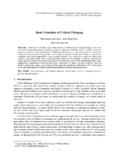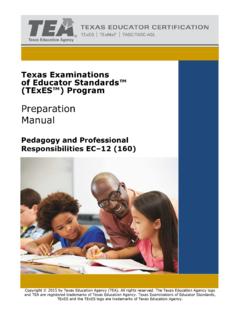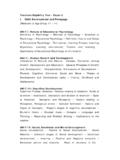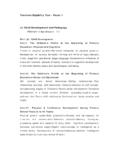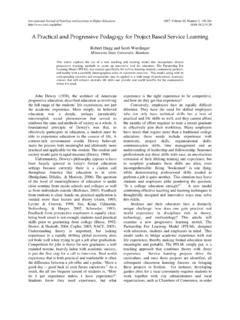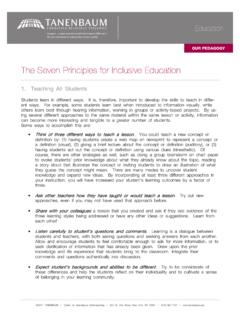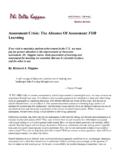Transcription of Critical Communication Pedagogy as a Framework …
1 5. Critical Communication Pedagogy as a Framework for Teaching Difference and Organizing Brenda J. Allen . A s organizational Communication scholars increasingly respond to calls to investigate difference and organizing, I urge them to heed a parallel and equally pressing need to incorporate differ- ence into their teaching. Scholars and teachers should strive to help stu- dents understand how varying dimensions of social identity articulate with one another, with a focus on the consequences of those articulations for organizing (Simpson & Allen, 2006). While difference is a focus of study in several fields, Communication scholars can offer students a uniquely communicative understanding of these issues and how humans (re)produce them.
2 Such an approach can provide pivotal insight and understanding to prepare students to interact effectively and humanely in contemporary organizational contexts, where matters of difference are ever more apparent and important. However, because teaching difference and organizing can be particularly daunting and complex, faculty can benefit greatly from resources that can guide their efforts. 103. 104 PART II: TEACHING DIFFERENCE AND ORGANIZING. One potential Framework for teaching difference and organizing is Critical Communication Pedagogy , a relatively new perspective that studies relationships between power and Communication in educa- tional contexts. In this chapter, I present Critical Communication peda- gogy as a useful approach for teaching organizing and difference.
3 I. begin by describing Critical Pedagogy the theoretical and philosophi- cal foundation upon which Critical Communication Pedagogy rests. Then, I lay out the Critical approach to Communication Pedagogy . Next, I suggest ways to apply Critical Communication Pedagogy to teaching organizing and difference, including an overview of an organizational Communication course about difference. Finally, I discuss the chal- lenges and benefits of using this approach. Critical Pedagogy . Critical Pedagogy is an approach to teaching and learning that seeks to analyze and transform educational contexts by applying principles of Critical theory (Giroux, 1997). Like Critical theory and Critical organiza- tion studies ( , Deetz & Mumby, 1990; Mumby, 1993, 2001), Critical Pedagogy strives to critique and change power relations in society.
4 However, Critical Pedagogy concentrates on educational contexts and related structures in society. More specifically, Critical Pedagogy advo- cates a social justice orientation for transforming oppressive educa- tional institutions into sites of emancipation and equality. Marking education as a crucial site of power dynamics, proponents of Critical Pedagogy examine impacts of dominant ideologies on teaching and learning, and they seek to create more democratic and socially respon- sible arrangements (McLaren, 2003). For example, they encourage edu- cators to become social activists, and they invite us to interrogate and revise our teaching perspectives and practices. As Henri Giroux (1994).
5 Explained, Critical Pedagogy signals how questions of audience, voice, power, and evaluation actively work to construct particular relations between teachers and students, institutions and society, and class- rooms and communities (p. 30). Critical Pedagogy relies heavily on the work of scholar-activist Paolo Freire (1970), who conceptualized liberatory education as a process where learners come to consciousness (conscientization). through praxis, which integrates Critical theory with reflection and practice. According to Freire, educational processes are not neutral;. they can either domesticate or liberate. That is, they can indoctrinate students to accept dominant ideologies and go along with the status quo, or they can raise students' consciousness by identifying and Chapter 5: Critical Communication Pedagogy 105.
6 Challenging those ideologies. Thus, a primary goal of liberatory edu- cation is to develop students' (and teachers') Critical consciousness of how power tends to serve some groups more favorably than oth- ers. The hope is that after students become more aware of these dynamics, they will be empowered and inspired to construct and enact alternate, more equitable social realities. To accomplish this goal, Freire recommended moving away from a traditional, passive banking model of education, in which educators deposit knowledge into students and reward those who regurgitate that knowledge, to a problem-solving approach that regards all subject matter as socio- historical constructs to be questioned and encourages students to challenge authority.
7 As one scholar explained: In this democratic Pedagogy , the teacher is not filling empty minds with official or unofficial knowledge but is posing knowledge in any form as a problem for mutual inquiry (Shor, 1992 p. 33). Freire (1970) also endorsed engaging students in dialogue for instance, by inviting them to name and narrate their own experiences and to relate those experiences to what they are learning. Critical Pedagogy enjoys an enduring tradition in the United States, and its proponents have developed numerous variations that retain the central aim of applying Critical theory to transform education (Giroux & Giroux, 2006). Contemporary advocates of Critical Pedagogy have extended Freire's work to encompass issues that are especially relevant for teaching difference and organizing.
8 Whereas Freire took a Marxist perspective that tended to focus on essentialist, class cate- gories, some Critical Pedagogy scholars have developed postmodern, constructionist conceptions of identity and difference ( , Giroux, 1994, 1997; hooks, 1994; McLaren, 2003). They acknowledge the impor- tance of difference and identity politics by adopting Critical perspec- tives that draw on feminist, performative, queer, and Critical Whiteness studies (see Fassett & Warren, 2007). They also emphasize complexities of identities, asserting that most people simultaneously embody iden- tities associated with privilege and oppression ( , Alexander, 1999;. Allen, 2004; Cooks, 2003; Johnson & Bhatt, 2003; Orbe, 1998).
9 As Critical Pedagogy infuses various disciplines, Communication scholars have begun to provide substantive insight and direction about the crucial role of Communication in Critical Pedagogy . Critical Communication Pedagogy . Communication scholars Deanna L. Fassett and John T. Warren (2007). developed Critical Communication Pedagogy as a Framework for 106 PART II: TEACHING DIFFERENCE AND ORGANIZING. studying relationships between power and Communication in educa- tional contexts. In this perspective, they position Communication as central to the processes through which humans reproduce or resist power relations. Critical Communication Pedagogy encompasses Critical theory's dedication to social change as a goal of research as well as Communication studies' analytical focus on mundane prac- tices (Warren, in press).
10 Fassett and Warren (2007) based Critical Communication Pedagogy on elements of Critical theory, Critical ped- agogy, and two areas of study in Communication : (1) Communication education, which focuses on how best to teach Communication , and (2) instructional Communication , which strives to improve classroom Communication processes in any discipline. Fassett and Warren began their efforts after Communication scholars in the early 1990s invoked Critical Pedagogy to interrogate conventional studies of communica- tion education and Communication instruction that typically focus on helping teachers to be more effective (Fassett & Warren, 2007;. Rodriguez & Cai, 1994; Sprague, 1992, 1993, 2002).

